| Reviews & Columns |
|
Reviews DVD TV on DVD Blu-ray 4K UHD International DVDs In Theaters Reviews by Studio Video Games Features Collector Series DVDs Easter Egg Database Interviews DVD Talk Radio Feature Articles Columns Anime Talk DVD Savant Horror DVDs The M.O.D. Squad Art House HD Talk Silent DVD
|
DVD Talk Forum |
|
|
| Resources |
|
DVD Price Search Customer Service #'s RCE Info Links |
|
Columns
|
|
|
Joe Sarno's Inga Collection (Inga, The Seduction of Inga, The Indelicate Balance)
Vintage American sexploitation―Swedish art-house style! Retro-Seduction Cinema has combined two of their previous releases to create the Joe Sarno's Inga Collection, a deluxe, three-disc set that features grindhouse/drive-in classic Inga, its sequel, The Seduction of Inga (a.k.a.: Inga and Greta), with another Swedish Sarno offering, The Indelicate Balance, as a bonus feature. As far as I can tell, the transfers and the copious amount of bonuses used here are the exact same ones that are found in the previous stand-alone releases of Inga and The Seduction of Inga, so there's no need to double-dip if you already have those discs in your collection. It's tough to pinpoint who the exact audience would be for something like Joe Sarno's Inga Collection: younger viewers brought up on instantaneous internet hardcore porn will liken this stuff to your average Doris Day sex comedy, while "film" snobs who have a tatty copy of Sarris' book by their bed, will equate Sarno to Bergman on the same level that one sees IKEA© laminated particleboard next to gen-u-wine hand-crafted furniture. I hate to say it...but I guess either old timers looking for some soft-core nostalgia...or hipsters looking to laugh at something old, are Joe Sarno's Inga Collection's best bet. Let's look very briefly at each movie.
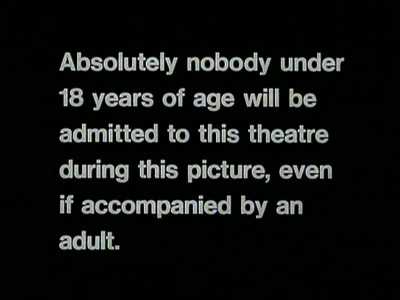
INGA
Widowed 34-year-old Greta Johannson (Monica Strömmerstedt) is in a jam. She's hooked up, rather hopelessly, with pretend "writer" Karl Nistad (Casten Lassen), who's not only quite a bit younger than her, but also a major freeloader who's eating up what's left of Greta's money. Greta's family maid, Frida Dagheim (Else-Marie Brandt), tells Greta to ditch Karl, but Greta, desperate to hang onto this symbol of her lost youth, refuses. Toothy, queasy-looking Einar Nilsson (Thomas Ungewitter) offers Greta a way out: keep him company in the bedroom and at respectable parties, and he'll pay her. Simple...only Greta doesn't love him like she does Karl (although she'll readily sleep with Einar), and besides, he's married to an invalid: no future there. Enter Inga Frilund (Marie Liljedahl), the 17-year-old daughter of Greta's recently deceased sister. Coming to stay with Greta, Inga is naïve sexuality personified (she reads Strindberg and can't figure out why the sight of wind-up mechanical soldiers turns her on), so Greta sees an opening: pimp Inga out to Einar (who everyone acknowledges prefers virgins anyway), and collect a weekly check―a plot that Einar's calculating sister, Sigrid (Sissi Kaiser), dreams up. So, will sweet, innocent Inga fall prey to these devious, self-serving, horny grown-ups?
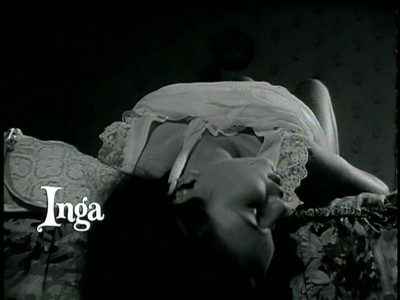
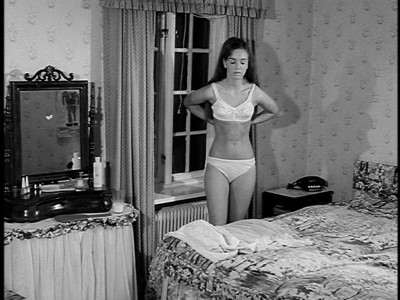
I've written before about Joe Sarno's work, and going back to re-read those pieces, the common theme that kept cropping up in those reviews was my admitted admiration for Sarno trying to do something, anything, different with the usually crudely constructed, pruriently-focused soft-core efforts of the 1960s and early 1970s...contrasted by my realization that if Sarno wanted his sexploitation numbers to be taken seriously as "art," then his work would have to be judged by the same standards as non-exploitation movies. If he was shooting for something more than what was largely coming from other moviemakers in that sub-genre, while deliberately disdaining from giving his audiences the usual conventions expected in these kinds of movies (Sarno's noted propensity at this juncture of his career to judiciously parse out his cleaner-than-standard sex scenes), then he shouldn't be given a "pass" for bad moviemaking just because he's working in reduced circumstances or because he's more "serious" in his intent.
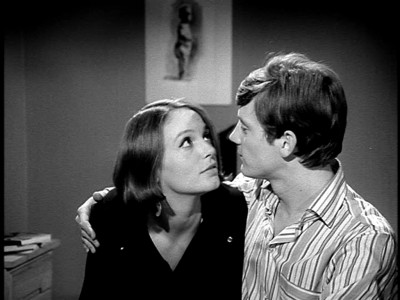
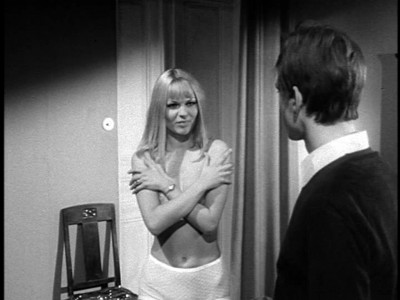
If critics and writers who champion Sarno for the scope of his ideas in his movies would be completely honest with themselves, they'd acknowledge that no matter how advanced Sarno's intellectual reach was in comparison to most moviemakers working then in the 60s grindhouse genre, Sarno's actual techniques (most critically: his screenwriting skills) were at best derivative of more skilled, more original so-called "legitimate" art house directors flourishing at that time. Granted, it's tough to say what an original Sarno movie looked like upon completion, because according to the director himself, it was a rare title of his indeed that didn't suffer at the scissor-happy hands of various producers and distribution chiefs. Still, listening to the director on these commentary tracks and in his interviews, what he usually complains about is the addition of more graphic sex scenes into his little art movies, not the excision of his various pointless longeurs. And since all three of the movies here in the Joe Sarno's Inga Collection have that same faux-European art house sense of pacing, construction, and performance despite their various cuts, it's fair to say that at the end of the day, Sarno was aping his "betters" (not a pejorative here, but used in terms of classification), coming up short against them...but still getting credit from some critics because his movies looked so good next to the dreck that made up 98% of the 60s sexploitation/grindhouse output.
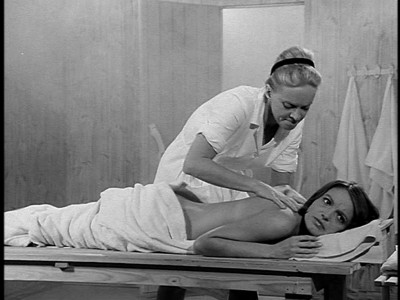
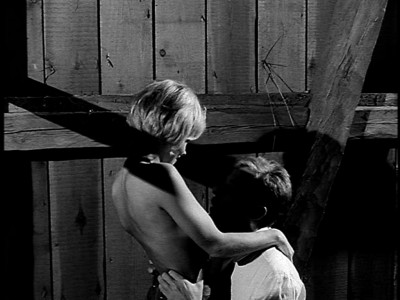
And Inga isn't any different. Certainly there's plenty of potential in the simple, familiar story for a skilled dramatist to pull out some interesting ideas and connect them up, but nothing of much importance is developed here by writer/director Sarno. A good example is the arresting opening shot. Inga, in her little nightie, looks at some wind-ups metal toys, and smiles as a group of tin soldiers march off away from her bed. Great. I'm all primed for a movie about a little Lolita who blossoms into a sexually confident woman who can control the people who wish to control her. Only...that's not Inga at all. In fact, the movie really isn't even about Inga as much as it's about Greta and her stale older woman/younger man romance. Other vague hints at potentially interesting themes are offered up...only to be ignored (those directionless youths wildly gyrating to the song, "Middle of Nowhere won't find direction in Sarno's script―he bypasses their plight completely). One of the most glaring is poor Karl, a woefully underdeveloped character who's largely somnambulant before insisting Greta take him away from everything (i.e.: Inga, who is driving him wild with desire). Why would shallow user Karl suddenly panic and worry about offending Greta by taking up with Inga (he's already cheated with the slutty blonde)? What does Inga represent, that Karl's afraid of? Your guess is as good as Sarno's. What is ultimately spelled out in Inga is Greta's romance, but that detailing never rises above the level of standard daytime soap opera histrionics.
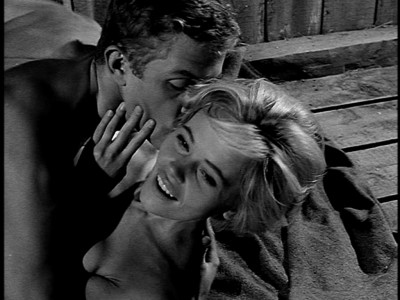
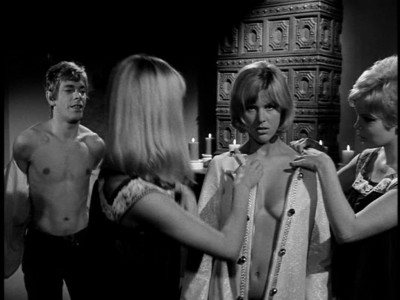
As for the real reason anyone is still watching and talking about Inga 40+ years later―the sex―it's impossible to judge it now, based on our own completely desensitized view of sex-on-film so many years later. You have to give Inga credit for showing what no mainstream Hollywood movie would have shown in 1967 (when Inga was filmed), and audiences certainly showed an eagerness to experience what everyone was whispering about―the notorious masturbation scene (everything else in Inga is strictly PG-13). Still...Sarno plays it safe and just shows her top half hanging over the bed as he focuses on her face. In all the commentaries I've heard with Sarno and others, everyone emphasizes that the sex is real on screen...as if actors can't just fake an orgasm, and as such, Marie Liljedahl's "work" here is somehow more valid and exciting because it's really happening. Perhaps. Aside from clinical interest, however, this scene didn't come off (sorry) any better than most of Sarno's overt sex scenes. There's always this standoffishness and hesitation to his sex scenes which may be rooted, weirdly, in all those comments about how nice and sweet and gentlemanly Sarno was during shooting―it's pretty difficult to conjure up a conglomeration of the opposites "gentility" and "passion." Inga may have been explicit in showing topless nudity, but in terms of heated eroticism, Liljedah's infamous scene seems more frenzied than truly sensuous (just by comparison, that same year's Cool Hand Luke, a big-budgeted Hollywood "product" for the masses―the genetic opposite of Sarno's work―had a memorably comic, erotic scene where Joy Harmon's breasts were bounced and pressed against a wet car window, while she squeezed and caressed some all-too-suggestive thick, white soap suds down her taut stomach. And kids were allowed to buy a ticket to that one).
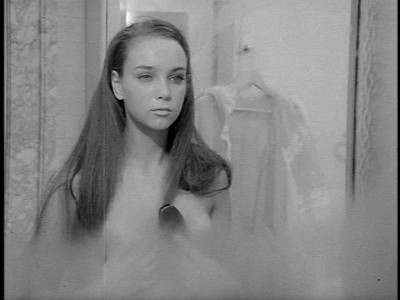
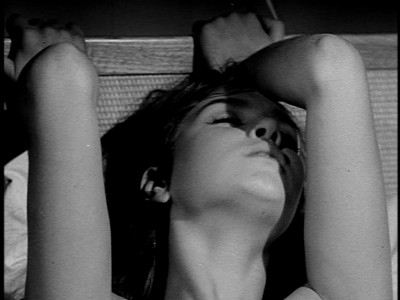
THE SEDUCTION OF INGA
Three years after the events in Inga, Inga (Marie Liljedahl), stranded in a crummy Stockholm bed-sit after Karl abandoned her, now wonders what will become of her. Recognizing the bed-sit's pimp as Lothar (Lennart Norbäck), the boy who almost date-raped her three years ago, Inga keeps her distance until Lothar convinces her he's a friend...especially if she wants to trick for Lothar's madame. Inga declines, but she does take him up on a chance to be author Stig's (Lennart Lindberg) secretary. Stig is writing a book about an older man's obsession with a young nymphet (uh oh...), and soon Inga and he are a couple. However, Stig leaves for a trip to New York and after no word from him for three weeks, Inga returns to Stockholm, where she befriends next-flea pit-neighbor Rolf (Tommy Blom), a budding guitarist in a local rock band. Inga doesn't want to fall in love with Rolf and get her heart broken, but bigger troubles soon mount: who is Greta (Inger Sundh), the snarly, sexy blonde that keeps watching Inga, and what does she have to do with the returning Stig?
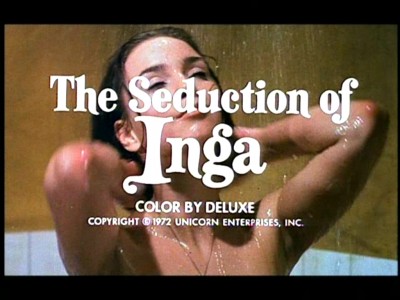
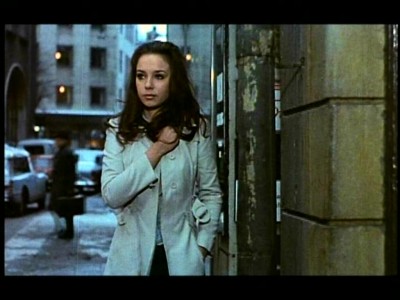
The last line in The Seduction of Inga is Inga's, as she listlessly offers, "I may be back...who knows?" Don't bother. A sequel cooked up on the spur of the moment (according to Sarno) just to capitalize on the runaway international success of Inga, 1972's The Seduction of Inga is even less successful than its inspiration, both in the drama and gettin'-it-on departments. Set largely in a dark, dank, depressing Stockholm bed-sit, The Seduction of Inga begins on a dreary note and stays there until the suspiciously "happy" (and second sequel-ready) ending. Taking yet another thin, obvious, soap opera-worthy storyline, scripter Sarno does little to inform it with even the most basic dramatic through-line, let alone anything deeper (and remember...that's what we're supposed to be looking for, since Sarno isn't going for sexploitation, but rather "art"). Basic story elements like why did Karl leave, how is Inga earning eating money is she's been abandoned for so long, why does she still looked shocked when she sees another orgy down at Lothar's, and why doesn't Stig contact her for over three weeks, are just a few of the questions Sarno leaves unanswered―and not, I suspect, in a deliberate effort to leave the story trendily "open-ended."
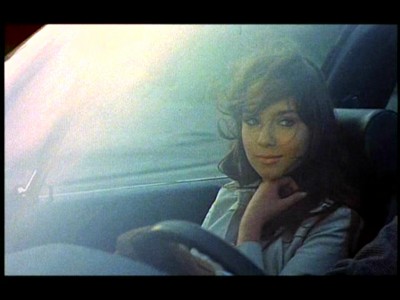
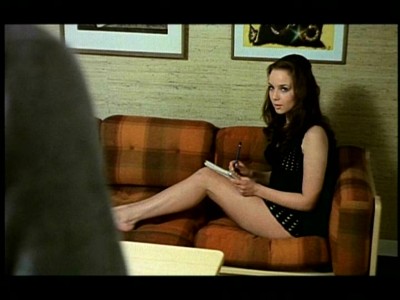
Even Sarno's framing, which can sometimes be quite interesting, is frankly un-informed this go around. Meaningful mise-en-scene is conspicuously absent, with actors in nondescript sets, crudely blocked squarely in front of the static camera (too bad, too, because the beautiful, talented Liljedahl could have been used to so much better effect). About the best I could do (for a laugh) was to pick out Inga's and Rolf's date, where they have hot dogs and popsicles (calling Dr. Freud!). Sarno occasionally drops in little inserts, like a shot of a Bardot poster "watching" Rolf and Marienne make love, that seem intriguing for a half a second before you realize there's no informed intent behind them. The druggy, draggy dramatic scenes aren't much better than the truncated sex scenes here (the "grindhouse" version of The Seduction of Inga has longer, rougher cuts...but only of the post-production, producer-shot material that Sarno disavows). Inbetween the frequently laughable dialogue ("Remember, Inga...you're my kind of girl!" Rolf inexplicably offers as a farewell), Sarno serves up his now-standard obsessions, including the de rigueur incest titillation...as well as the equally predictable amelioration of that uncomfortable set-up: give the patron some taboo jollies, and then make it all go away by having the participants not related by blood. At the climax (sorry) of the movie, when Greta goes butch and pulls a broken bottle on Inga a la Burt Lancaster, I completely threw up my hands at The Seduction of Inga's wily-nily, essentially pointless exercise in disconnected, numbed eroticism.
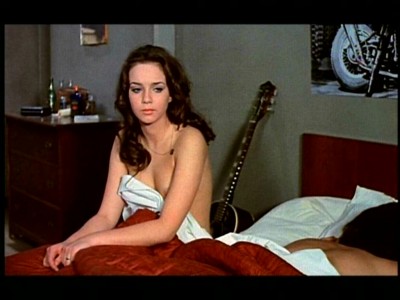
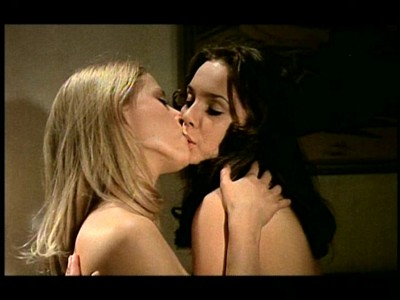
THE INDELICATE BALANCE
(Since the credits for this super-rare print don't give actor/character listings, I'll just put what we know as far as the actors go here: Kim Anderzon, Ulla Danilesson, Ittla Frodi, Bo Högberg, Peter Kneip, Jim Steffe, and Louise Tillberg). Emotionally blocked and unable to paint for the last eight months (that's not all he can't do these last eight months...), artist Harald returns home after four years, bringing his new wife Karin along to meet his family. Hoo boy. Mom Lena is only 14 years older than Harald, and seems to have a very...strong hold on her son. Sister Ingrid, as well, has been known to hold onto Harald; the last time she did, Lena kicked her out of the house (Lena's husband Tom doesn't mind, though―incest turns him on). Sister Gunnel is wise to everything that's going on, and dopey brother Gost just smiles and heads out to read skin mags by his tractor. When the reality of their isolation out in the depths of the Swedish rural winter sinks in with Karin, she begins to fear for Harald's―and her―sanity when Lena monopolizes more and more of Harald's time. Good thing Ingrid is always there to give Karin a massage...and anything else she wants.
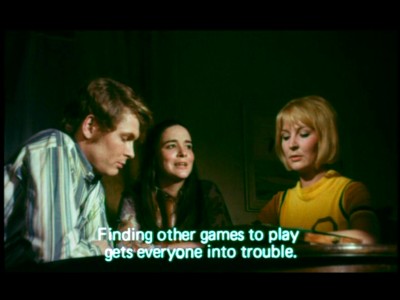
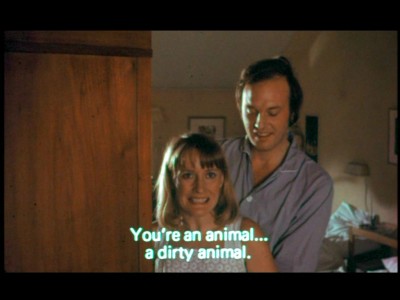
The best of the three offerings here in the Joe Sarno's Inga Collection, 1969's The Indelicate Balance comes closest (of the Sarno movies I've seen) to the Bergmanesque ideal that Sarno was so obviously trying to imitate. Evocatively set in a snowy, isolated Swedish farm house (good location work here), Sarno stays put in a series of claustrophobic studio sets, moving from one bedroom or living room or painter's studio to the next, slowly tightening the psychological screws on his deeply dysfunctional characters...until he trots out the dopey sexual politics of the piece and pretty much blows the whole thing into easy, safe melodrama. The cast, made up of Stockholm theater actors who were one-shot Sarno participants, is quite good, bringing a technical facility to their turns that you don't often seen in other Sarno works. Had Sarno the scriptwriter kept things intriguingly vague without spelling out each and every desire each and every character had, and then offering either concrete gratification or nullification for all, The Indelicate Balance might have been a memorable little art house flick. However, Sarno can't resist going broader and broader, making the sexual dynamics increasingly obvious...and predictably safe.
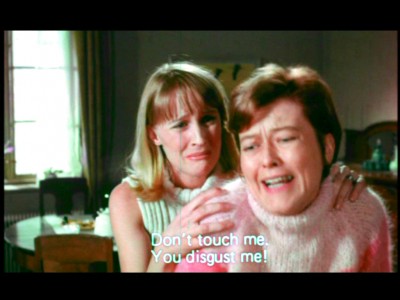
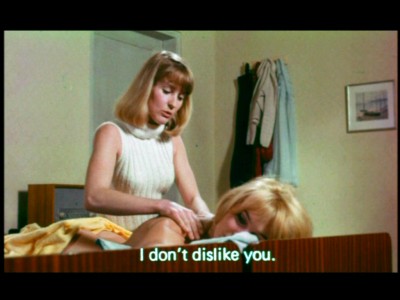
Had Sarno really tackled the extremely unpleasant incest angle with honesty, again, The Indelicate Balance might have had some impact. However, the minute you hear Harald's mother was quite young when he was born, you can guess where Sarno is going with it all, and sure enough, we discover there's no legal incest occurring here between mother and son―only between half-brother and sister (which Sarno must have thought was more amenable to viewers, before he excuses it away not as a sexual act, but one of emotional revenge). For critics who say that's okay; Sarno is just roping in the viewer by titillating them and then yanking (sorry) the rug out from under them, I'd agree...if he didn't always do this. Sarno's incest bait 'n' switches never feel like sophisticated moral shell games that compromise the viewers; they always feel like mechanically calculated "effects" that he hopes comes off as valid dramatic twists...but which seem to be merely sops to the censors and perhaps, to his own qualified, unresolved feelings about the subject. By the middle of the movie, we're two steps ahead of The Indelicate Balance all the way, with tame sex scenes either planned that way by careful, cautious Sarno, or dropped during some post-production mauling, with the final resolution coming off as bad Oscar Wilde, not O'Neill or Strindberg. If there's any movie I've seen from Joe Sarno that proves positive he was a potentially gifted moviemaker who ultimately turned out to be a minor talent (in a limiting genre, we must remember, that he deliberately staked out as his own), it's The Indelicate Balance.
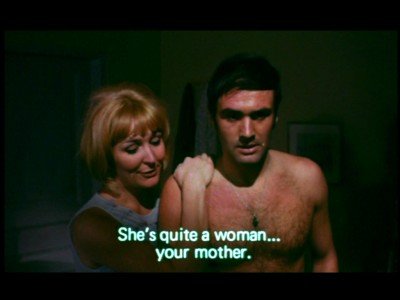
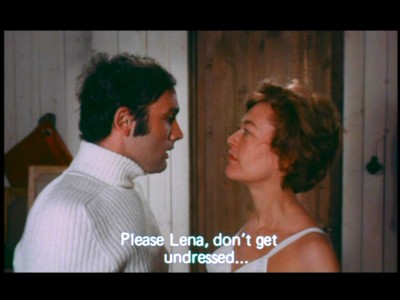
The DVD:
The Video:
Inga is presented in a full-screen, 1.33:1 black and white transfer that's quite nice, with a reasonably sharp image, okay blacks, some brief contrasty moments, and the expect screen imperfections. When you get to disc two and The Seduction of Inga...I recommend you put the disc back and watch the "grindhouse" version of The Seduction of Inga on disc three. It's presented in a flat 1.60:1 widescreen transfer that's miles above disc two's full-screen image, with mostly solid color, a sharpish image at times, and okay contrast. The full-screen version is fuzzy, with solarized color and lots of jaggies. On disc three, The Indelicate Balance, considering it is a "lost" movie that probably didn't have a threatrical release, looks...okay, with in and out color (lots of color shifts), a sharpish image at times, and occasional, understandable print damage (someone on the commentary states it may have been a work print submitted for a MPAA rating).
The Audio:
All the movies except The Indelicate Balance are dubbed mono English, with Inga also available in Swedish, and The Indelicate Balance only available in Swedish. English subtitles are available for all the movies.
The Extras:
Lots of extras. Inga has an "alternate" Swedish version (everyone agrees there's really no difference), along with a commentary track with the Sarnos (Peggy Sarno pretty much sets the tone with her first comment: "I don't remember the story."). An audio "interview" with star Marie Liljedahl, who reads answers to text questions. It runs 8:53. Some outtakes are included (9:14), along with two original trailers for Inga, as well as other Retro-Seduction titles. For The Seduction of Inga, there's a documentary on the saga, running 20:04. Producer Vernon Baker speaks about the movie; it runs 1:42. Inga's Theme (ABBA!!!) is a fun loop cut to scenes from the two movies, and trailers are also included. And for The Indelicate Balance, there's a commentary track with Peggy Sarno.
Final Thoughts:
Hey, you know how I am with these kinds of movies. I want to say, "Hey, they're old and kind of goofy, and the girls look good, so who cares if they're stupid? Just enjoy it!" Unfortunately, I just can't get past all the talk about what a genius Sarno is, just because his movies don't blow quite as much as most of the other sexploitation entries from that period. A rental is best for the Joe Sarno's Inga Collection.
Paul Mavis is an internationally published film and television historian, a member of the Online Film Critics Society, and the author of The Espionage Filmography.


|
| Popular Reviews |
| Sponsored Links |
|
|
| Sponsored Links |
|
|
| Release List | Reviews | Shop | Newsletter | Forum | DVD Giveaways | Blu-Ray | Advertise |
|
Copyright 2024 DVDTalk.com All Rights Reserved. Legal Info, Privacy Policy, Terms of Use,
Manage Preferences,
Your Privacy Choices | |||||||














